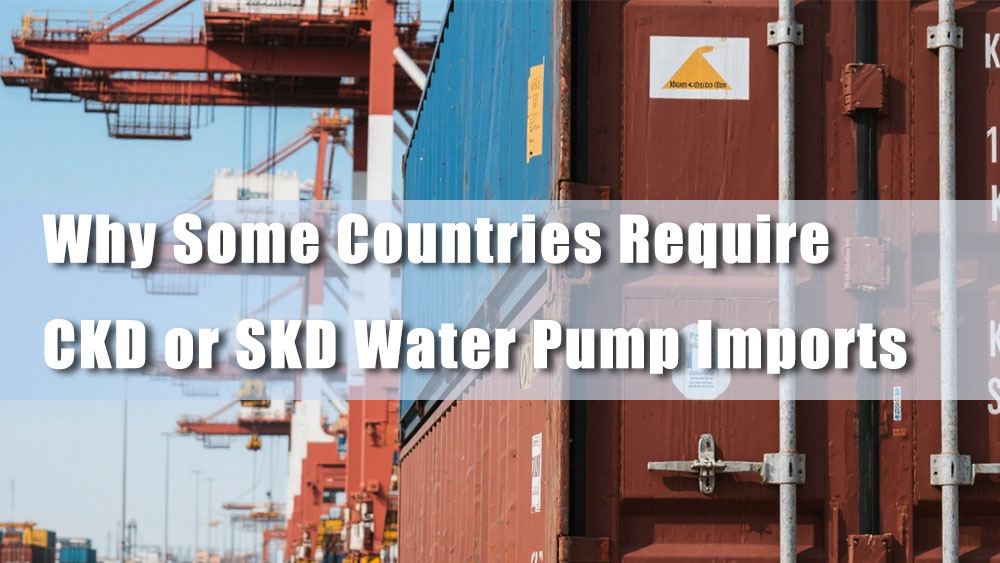+86 13816508465
Pump Knowledge
Aug. 07, 2025

Navigating the complexities of international trade can be challenging, especially for manufacturers, exporters, and buyers in the water pump industry. Among these challenges is understanding why certain countries require water pumps to be imported in CKD (Completely Knocked Down) or SKD (Semi Knocked Down) form. This blog explores the reasons behind these requirements and provides practical strategies to help you comply while maximizing the benefits of these regulations.
CKD and SKD Defined
CKD (Completely Knocked Down) and SKD (Semi Knocked Down) refer to production and assembly methods where goods are partially or completely disassembled before shipping.
CKD components arrive fully disassembled, requiring significant local assembly.
SKD products are partially assembled but still require some degree of local assembly to become operational.
Key Differences and Industry Examples
The difference lies in the level of assembly required:
A CKD water pump might arrive as separate parts like the motor, casing, impeller, and seals.
An SKD water pump could include a pre-assembled motor-casing unit, with only minor tasks like connector attachment left for local assembly.
These formats allow water pump exporters to adjust their products for specific market conditions and local requirements.
Advantages and Challenges
Advantages:
Reduced import tariffs in many countries.
Flexibility for manufacturers to comply with local industrial policies.
Opportunities for product customization to meet regional needs.
Challenges:
Higher logistics and packaging costs.
Increased complexity in supply chain management.
Need for collaboration with local partners for assembly and distribution.
Several factors influence countries to mandate CKD or SKD imports, from economic considerations to technical requirements. Let's look at these factors in detail.
Local Industrial Policy and Job Creation
Many governments aim to stimulate local economies by requiring imported goods to be assembled domestically. CKD and SKD imports support this goal by:
Creating jobs in assembly plants for skilled and unskilled workers.
Encouraging investment in local infrastructure, such as manufacturing facilities and training programs for workers.
For example, countries like India and Indonesia have implemented policies that incentivize local assembly to enhance industrial capacity.
Taxation and Import Tariffs
Differentiated import tariffs play a significant role in why CKD and SKD formats are preferred by many nations:
Lower import taxes are often applied to disassembled parts as opposed to finished goods. This provides a cost-saving incentive for importers.
Countries such as Brazil impose higher tariffs on fully assembled water pumps to protect domestic industries, making CKD or SKD formats a more economical choice.
Compliance with Local Content Requirements
To encourage local production, some governments set local content requirements—rules mandating that a percentage of a product must include locally sourced components. CKD and SKD imports enable:
Local integration by allowing water pump assemblers to incorporate regionally manufactured parts like gaskets or couplings.
Access to government incentives, such as tax breaks or subsidies, for meeting local content criteria.
Technical and Customization Needs
Every market has unique technical requirements, such as voltage standards for motors or compatibility with locally available components. CKD and SKD formats make it easier to:
Adapt products to meet environmental challenges or customer preferences, such as using corrosion-resistant materials in coastal regions.
Ensure compatibility with locally made parts, reducing costs and service complexities.
Several countries mandate or incentivize CKD/SKD formats to leverage their economic and policy advantages:
India and Indonesia emphasize local assembly to support industrial growth and reduce dependency on imports.
Brazil imposes prohibitively high tariffs on finished products, encouraging CKD/SKD imports to maintain competitive pricing.
Many African and Middle Eastern countries use CKD and SKD policies to accelerate industrialization and job creation.
For manufacturers and exporters, understanding these regional nuances is critical to ensuring smooth entry into these markets.
Adapting to CKD and SKD requirements leads to both opportunities and challenges. Here's how these policies impact the water pump supply chain:
Flexible Supply Chains: Manufacturers must develop modular product designs and assembly processes to accommodate CKD/SKD requirements.
Pricing and Packaging: Exporters incur additional costs for customized packaging and logistics to ship disassembled parts safely.
Local Partnerships: Collaborating with regional partners for assembly and compliance is crucial for success in CKD/SKD markets.
After-Sales Support: Businesses must also consider warranties, servicing needs, and spare part availability when designing for CKD/SKD assembly.
To succeed in CKD/SKD markets, manufacturers and exporters must adapt their strategies. Here are some practical steps:
1. Engineer for CKD and SKD Assembly
Design products with disassembly and reassembly in mind. Modular designs reduce assembly time and minimize complexity for local partners.
2. Foster Local Partnerships
Partner with local businesses for assembly, distribution, and compliance. Joint ventures can mitigate risks and strengthen your market presence.
3. Prioritize Compliance
Ensure compliance with local import/export documentation, tariff classifications, and content regulations. Work closely with customs experts to avoid delays.
4. Optimize Logistics
Plan for specialized packaging and transportation needs. Disassembled goods require extra care to prevent damage during transit.
CKD and SKD imports present both challenges and opportunities for the water pump industry. While they require careful planning and flexibility, these formats can help manufacturers and exporters unlock new markets, reduce costs, and comply with local regulations. By investing in modular designs, fostering local partnerships, and optimizing logistics, your business can turn CKD and SKD requirements into strategic advantages.
Take the first step today—review your product lines for CKD/SKD compatibility and start exploring markets where this approach can drive growth.
Address
No.17 XeDa Jimei Ind. Park, Xiqing Economic Development Area, Tianjin, China
Telephone
+86 13816508465
QUICK LINKS